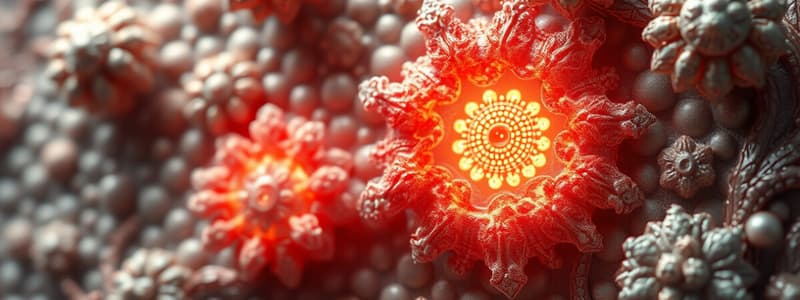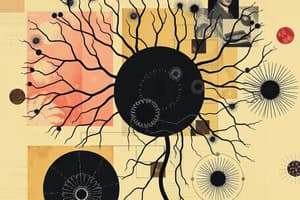Podcast
Questions and Answers
What are Corpuscles of touch (Meissner corpuscles)?
What are Corpuscles of touch (Meissner corpuscles)?
Tactile receptors that are sensitive to touch.
What sensations do corpuscles of touch (tactile corpuscles) provide?
What sensations do corpuscles of touch (tactile corpuscles) provide?
- Touch
- Pressure
- Vibration
- All of the above (correct)
Where are Lamellated (Pacinian) corpuscles commonly found?
Where are Lamellated (Pacinian) corpuscles commonly found?
In deeper subcutaneous tissues, tendons, and ligaments.
What do Lamellated (lamellar) corpuscles detect?
What do Lamellated (lamellar) corpuscles detect?
What is the major function of Golgi tendon organs?
What is the major function of Golgi tendon organs?
What do muscle spindles help with?
What do muscle spindles help with?
What is the purpose of a root hair plexus?
What is the purpose of a root hair plexus?
Where are Merkel cells found?
Where are Merkel cells found?
What type of sensations do tactile discs (TYPE 1) respond to?
What type of sensations do tactile discs (TYPE 1) respond to?
What do Ruffini corpuscles respond to?
What do Ruffini corpuscles respond to?
Where are bulbous corpuscles (type 2) located?
Where are bulbous corpuscles (type 2) located?
Flashcards are hidden until you start studying
Study Notes
Sensory Receptors Overview
- Corpuscles of Touch (Meissner Corpuscles): Sensitive tactile receptors responsible for detecting light touch.
- Tactile Corpuscles: Provide sensations of touch, pressure, and vibration.
- Lamellated (Pacinian) Corpuscles: Located in deeper tissues; detect heavy pressure and vibrations.
Mechanoreceptors Specifics
- Lamellated (Lamellar) Corpuscles: Mechanoreceptors in glabrous skin; sensitive to sudden changes in pressure and vibrations. Also found in the pancreas, indicating their role in detecting vibrations and low-frequency sounds.
- Golgi Tendon Organs: Located at the junction of muscle fibers and tendons; sense muscle tension during contraction and send signals about exerted force to the brain.
- Muscle Spindles: Inform the brain of muscle contractions and play a crucial role in proprioception, helping determine the position and movement of body parts.
Skin Mechanoreceptors
- Root Hair Plexus: A network of nerve endings around hair follicles; it is highly sensitive and detects movements of hair.
- Merkel Cells (Type 2): Found in the basal epidermis; responsible for detecting mechanical pressure, position, and deep static touch characteristics such as shapes and edges.
Touch Sensitivity
- Tactile Discs (Type 1): Nerve endings sensitive to light touch; most effective at detecting vibrations between 10 to 50 hertz. Primarily located in thick hairless skin, particularly on finger pads.
- Ruffini Corpuscles: Located in deeper skin layers, they respond to sustained pressure with little adaptation. Also register joint mechanical deformation and angle changes up to 2.75 degrees.
- Bulbous Corpuscles (Type 2): Slowly adapting mechanoreceptors found in cutaneous tissue between dermal papillae and hypodermis, responding to deep tissue pressure.
Studying That Suits You
Use AI to generate personalized quizzes and flashcards to suit your learning preferences.




